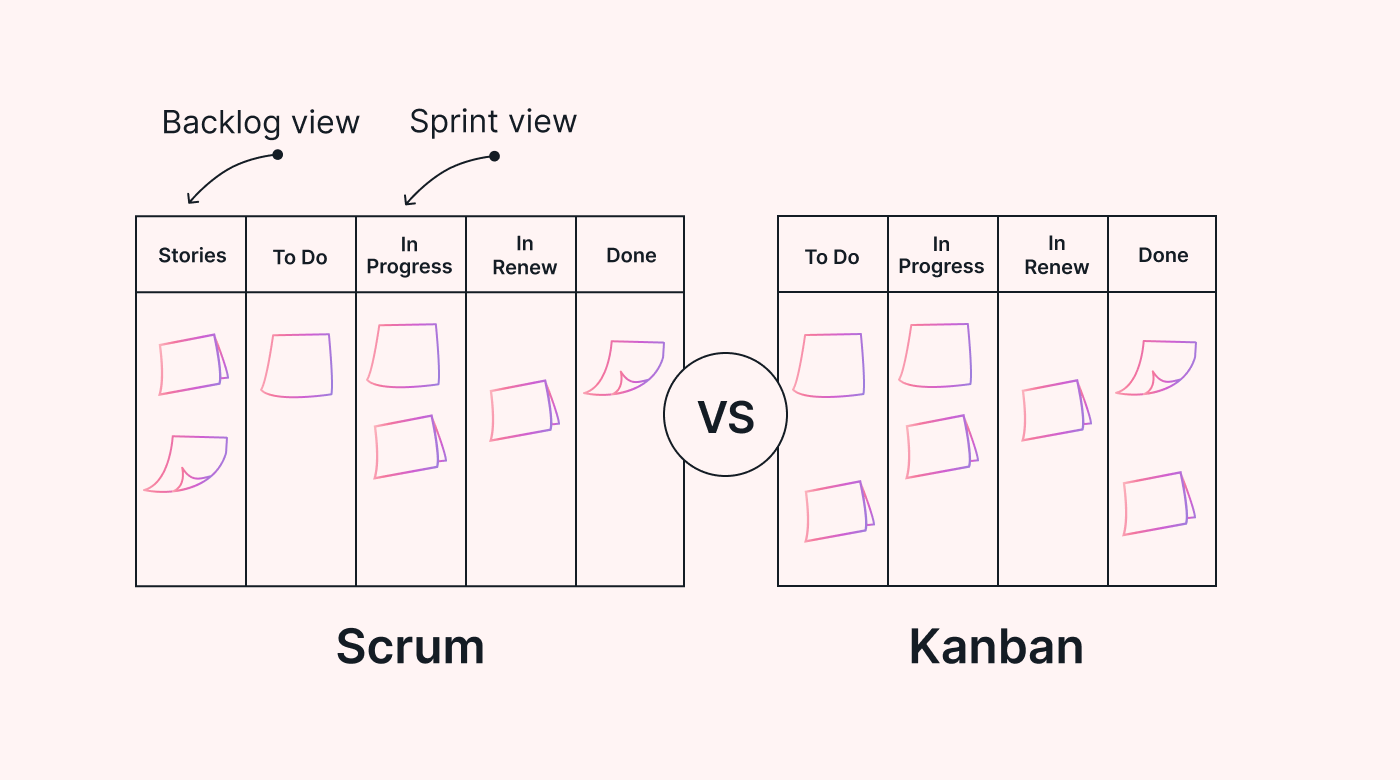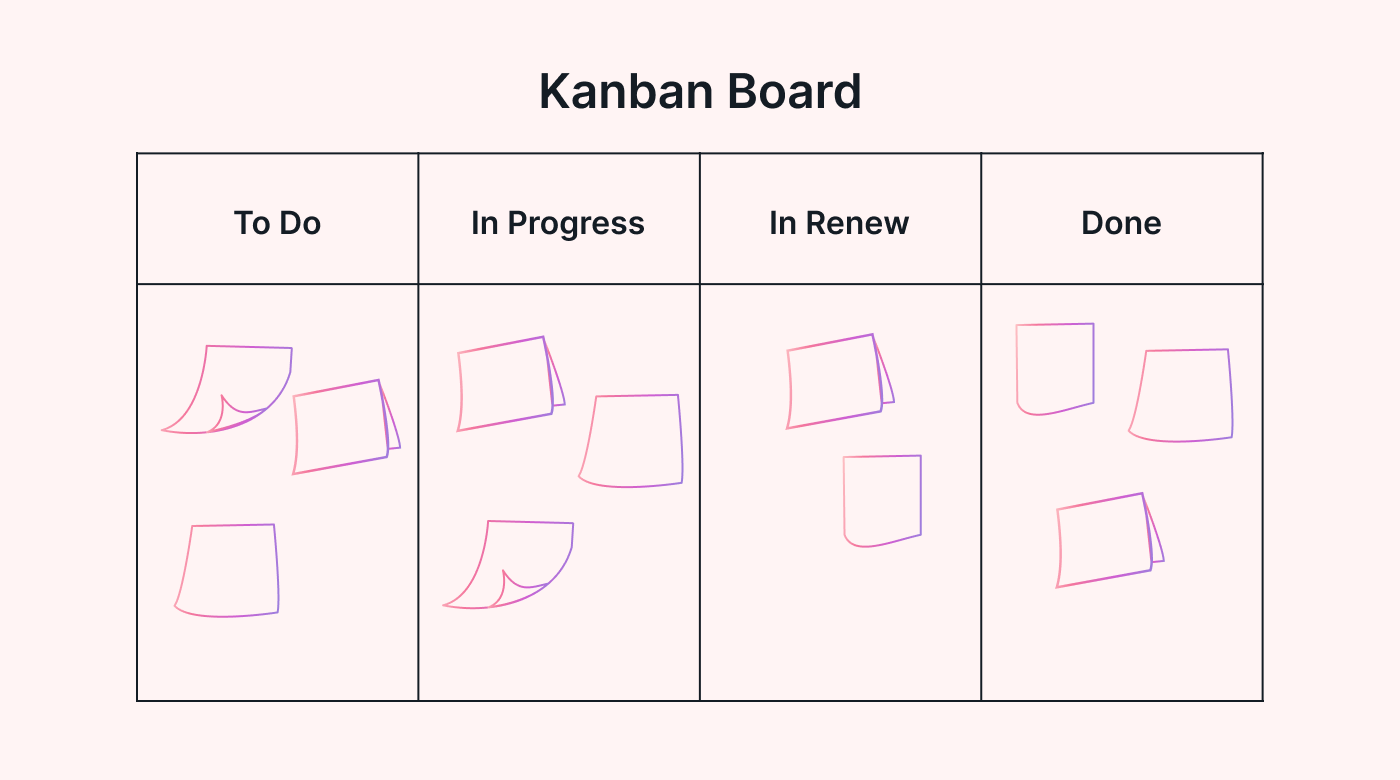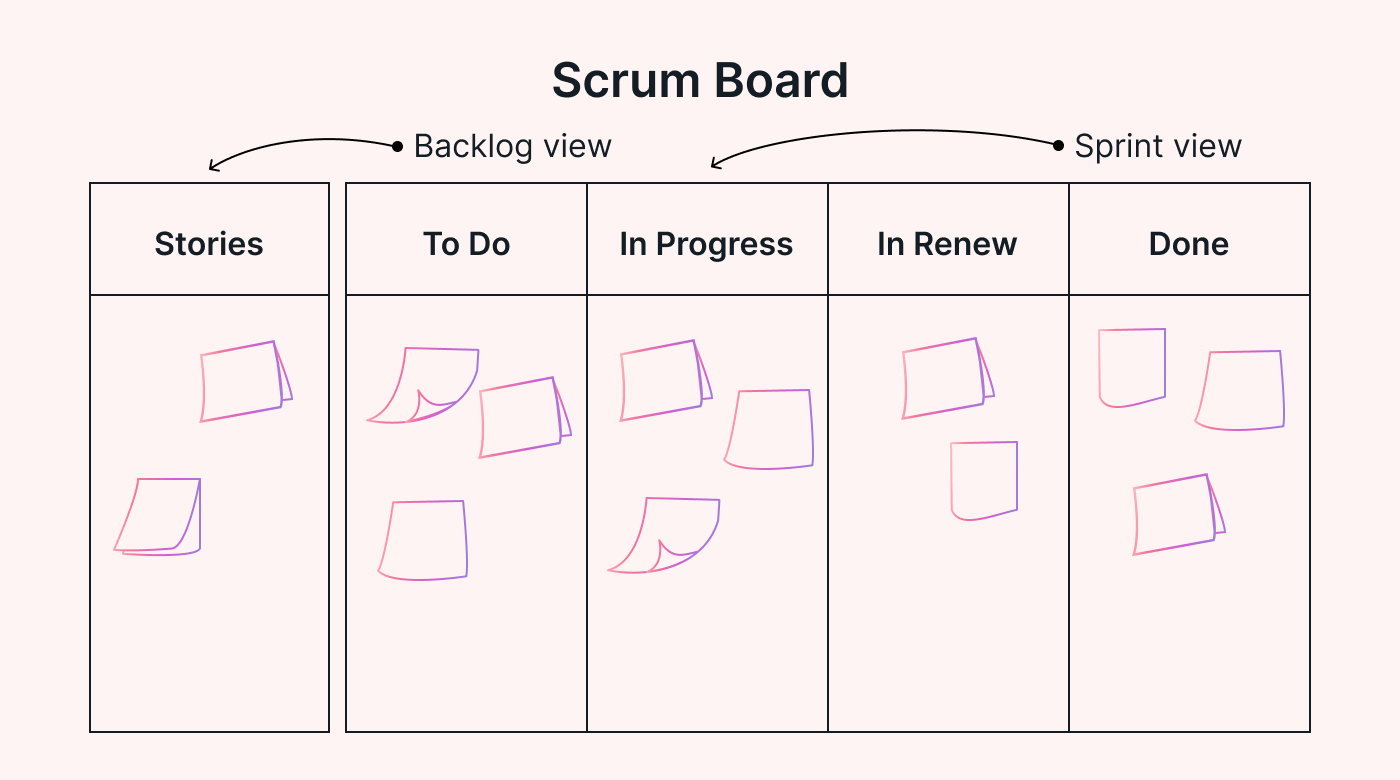As an Agile project team leader, it's your job to maximize your team's efficiency and productivity. But with so many different frameworks, deciding which is the best fit for your team can be difficult.
Enter Kanban and Scrum — two of the most widely used Agile frameworks. Both have their advantages, but which is the best match for your team? You need an Agile framework that will help your team stay organized and productive. But, with enough room to remain flexible and creative.
This article will explore Kanban and Scrum in detail so you can decide which framework is right for your unique needs. We'll discuss their differences and similarities so you can confidently choose the best option for your team.
Overview of Agile frameworks
As a project manager, your job is to break down project milestones and communicate them to your team. You know better than anyone that poor communication decreases team morale.
So, you might be surprised to learn that only 46% of organizations consider project management as part of their culture. That’s almost half!
In part, this could be due to a lack of knowledge about project management approaches that align business goals and a creative culture. It's important to find a project management framework that suits the way your team works best.
This is where Agile shines. Its approach emphasizes collaboration, flexibility, and rapid iteration to deliver on goals.
Agile involves breaking down large, complex projects into smaller, more manageable tasks. Other common aspects of Agile are frequent check-ins and the flexibility to adjust project milestones in real time.
Agile was formalized in the 1990s when a group of software developers came together to create the Agile Manifesto. This document outlines principles for a more flexible approach to product and services development. Now, Agile is one of the most popular frameworks for all kinds of production.
Agile has many frameworks that make managing projects easier. Two popular frameworks are Kanban and Scrum.
35% of executive leaders cite organizational agility as the most important factor in their success. Agile project management offers several benefits, including:
- Faster time to market: Agile teams can deliver to market faster. This is because they break projects down into small pieces. Then focus on creating a working product. Rather than getting stuck trying to create a "perfect" product.
- Increased flexibility: Agile allows teams to adjust to changing requirements and priorities. This results in more adaptable and responsive products or services.
- Enhanced collaboration: Agile emphasizes collaboration and communication among team members. This means better teamwork and improved productivity.
- Improved quality: Frequent testing and iteration is key to Agile. This leads to higher-quality products and services that better meet customer needs.
- Greater customer satisfaction: Agile teams focus on customer satisfaction. By gathering client feedback often, products are better able to meet customer needs.
While Agile has many benefits, it's important to choose the right framework for your team. Different frameworks, such as Scrum and Kanban, have different strengths and weaknesses. Choosing the right one can help your team work more efficiently and deliver better results.
Understanding Kanban and Scrum
A 2022 Project Management study notes many project managers lack Agile knowledge. There has never been a more important time to upskill. So let’s dive into two popular frameworks attributed to Agile: Kanban and Scrum.
Kanban and Scrum are both popular Agile frameworks used in project management. They improve team collaboration and deliver projects in an iterative and flexible way.
Kanban is a visual framework that emphasizes the flow of work and uses a ‘pull’ system to manage work in progress. The goal of Kanban is to maximize efficiency by limiting the amount of work in progress. This improves the flow of work, and reduces bottlenecks wherever possible. Kanban focuses on having the team complete one task at a time before ‘pulling’ the next task from the backlog.
Kanban’s origins go back to the 1940’s to industrial engineer Taiichi Ohno. Kanban, from Japanese “Kan” 看 meaning ‘sign,’ and “Ban” 板 meaning ‘board’ has roots in simplifying Toyota car manufacturing.
Scrum, while still an iterative framework, uses a ‘push’ system to manage work in sprints. Scrum focuses work in short, time-bound bursts and enforces planning tasks in advance. During each sprint, the team focuses on delivering a set of features. They meet in daily, short ‘standup’ meetings to discuss progress and obstacles.

Both frameworks are similar in their emphasis on collaboration, flexibility, and continuous improvement. The critical difference between Scrum and Kanban is in how they manage workloads.
Scrum follows a push system, pushing work into the workflow through the sprint planning process.
Kanban follows a pull system where work is pulled into the workflow based on capacity and demand.
Kanban is more flexible in adapting to changes in demand. Scrum is better suited to complex projects with a fixed set of requirements scheduled in advance.
Key differences between Kanban and Scrum
While both aim to improve the efficiency and quality of a project, these frameworks differ in their approach and methodology. The key differences between Kanban and Scrum are:
1. Time frame and workflows
Scrum is an iterative and incremental framework that follows a fixed time frame or ‘sprint’ with a predetermined objective to complete within this time frame. Kanban focuses on continuous delivery with no specific time-boxed sprint periods.
2. Team structure and roles
Scrum has specific roles. The team is small, usually no more than 9 team members, and is led by the Scrum Master. The team chooses a product owner; collectively, the remainder become the development team. Kanban does not have defined roles, focusing instead on the details of the DoW (Definition of Workflow). The DoW determines as a team what 'started' and 'finished' mean, and what time frames are appropriate for a task to be in each column.
3. Planning and prioritization
Scrum relies on comprehensive and detailed planning and prioritization at the beginning of the sprint cycle. As the project manager pushes out tasks to the team, expectations are clear, and work can begin immediately.
Kanban emphasizes continuous planning and prioritization throughout the project. As the project manager pulls tasks from the backlog the focus remains on demand.
4. Work items and outcomes
Kanban uses work-in-progress (WIP) limits to manage the flow of work through the system, limiting the number of tasks in progress at any given time. Scrum doesn't have any specific WIP limits outside of normal constraints, such as team capacity or resource availability.
Where Scrum delivers outcomes at the end of sprints, with Kanban, you can deliver work continuously as completed.
Similarities between Kanban and Scrum
1. Flexibility
Both frameworks focus on flexibility. This allows teams to make adjustments and changes as needed. Kanban’s pull-based system lets teams adjust their workflow based on demand. Scrum's iterative approach allows teams to adapt to changing customer needs and requirements.
2. Iteration and incremental development
Both frameworks use an iterative and incremental approach to project management. Using this approach, teams can deliver value early and often. Both Kanban and Scrum break down large projects into smaller tasks. This allows for faster delivery and better outcomes.
3. Focus on customer needs
Both Kanban and Scrum emphasize the importance of meeting customer needs. Both frameworks involve regular communication with customers and stakeholders. This ensures project goals align with business objectives and customer satisfaction.
4. Continuous improvement
Both frameworks also focus on continuous improvement. They use regular reviews and reiterations to identify areas for improvement. Then adjust processes as necessary.
Both Kanban and Scrum encourage teams to regularly check their performance and make changes as needed. Also encouraging teams to optimize their workflow to deliver better results.
We’ve looked at the similarities and differences between Kanban and Scrum. But, to make your decision simpler, let’s also take a look at the advantages and disadvantages of Kanban vs. Scrum.
Advantages and disadvantages of Kanban vs. Scrum
Inadequate project management processes waste 11.4% of organizational resources. So choosing the right framework is crucial. But what are the advantages and disadvantages of each? Let’s take a look.

Advantages of Kanban
Kanban visually displays tasks in vertical columns. This allows for easy status tracking and identification of potential bottlenecks in advance. The flexibility of Kanban allows teams to make changes in real-time.
By limiting how much the team can work on at once, teams can focus on completing tasks before moving on to the next. This methodical approach leads to higher-quality work. Additionally, Kanban prioritizes continuous improvement. Teams can refine their processes over time to build on progress in real-time.
Disadvantage of Kanban
The main disadvantage of Kanban is the limited predictability of delivery dates. This is due to its focus on flexibility and the absence of defined roles and responsibilities. This lack of structure can create confusion among team members. To counter this, assign task owners and deadlines to make accountability obvious across your team when work is pulled into the workflow.

Advantages of Scrum
Scrum provides a clear project management process with defined roles and responsibilities. This leads to improved team collaboration and provides clarity around accountability. It focuses on iterative development. By using short sprints of focused work, teams have the ability to quickly adjust to changes.
The push approach of Scrum assigns tasks in advance. This provides you and your team more predictability around deliverables.
Disadvantages of Scrum
The key disadvantage of Scrum is its rigid framework. Because all tasks are prescheduled, there can be problems when managing multiple complex projects at once. The constant pace of work tasks can also lead to team burnout if not managed effectively. This is because the only limit to workload is the capacity of your team which can be easily over-estimated.
How to choose the right Agile framework
The 2022 State of Agile report names Scrum the most dominant framework in Agile, with 87% applying Scrum. But does that automatically make Scrum the right choice for your organization? In a word, no.
The selection of an Agile framework will depend on several factors. Here are just a few:
- Team size and composition: The size and composition of your team can be important when selecting between Scrum and Kanban. Scrum is well-suited to large, inter-departmental teams with clearly defined roles and responsibilities. Kanban is better suited to smaller teams with more flexible deadlines. Especially if team members have multiple roles.
- Culture: Team culture plays a significant role in determining how your team will adopt your chosen framework. Creating a change-receptive culture is a top priority for many organizations. The choice between Kanban and Scrum must reflect your organization’s goals and culture.
- Type of work: The type of projects you’ll be using the framework for is also a crucial factor. Kanban comes from Total Quality Management (TQM) and Kaizen (continuous improvement). It is the best choice for ongoing work practices. But at a tactical level, Scrum might provide the structure and diligence your team needs to stay on task.
- Available resources: This can also be a crucial factor as Scrum requires a lot of resources, including a dedicated Scrum Master. Kanban relies on small teams with less defined roles. This makes it a more cost-effective approach in terms of training and upskilling costs.
- Desired level of flexibility: The level of flexibility you want is important to think about when deciding between Scrum and Kanban. Kanban offers more flexibility, allowing for changes to be made in real-time. But, Scrum is more rigid in its structure, requiring more planning and preparation.
- Timelines and deliverables: Timelines and deliverables can also be a factor in your decision. Scrum suits projects with fixed timelines and clear deliverables. Kanban is better suited for ongoing work with less-defined timelines.
Implementing Kanban or Scrum in your organization
As we’ve explored, Kanban and Scrum are two popular Agile frameworks. Each has its own set of benefits that you can evaluate when choosing the best fit for your team.
If a clear choice isn't already apparent, why not test both frameworks? An automated project management tool like Motion can give you the flexibility to adapt your approach in real-time. Find the best Agile framework for your team while saving time and resources.
Motion can reduce manual planning time, allowing your team to focus on the tasks that yield the best results. Start exploring your project management options and discover how Motion can help you better manage your team. Grab your 7-day free trial today.





